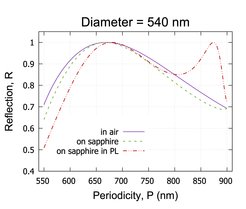Silicon nanospheres for improved gravitational-wave detection
Important first steps towards a novel mirror coating for precision metrology applications
Researchers from Leibniz University Hannover, the cluster of excellence PhoenixD, and from the University of Southern Denmark have investigated the properties of a silicon nanosphere metasurface mirror on a sapphire substrate via computer simulations with finite element methods. The material consists of periodically arranged silicon nanospheres embedded in a protective layer on top of a sapphire substrate. It is only nanometers thick and achieves high reflectance with a single layer. This has several advantages compared to the dielectric mirror coatings currently in use: it avoids internal friction between multiple layers of different material and promises lower mechanical loss and less resulting displacement noise. The authors did detailed modeling to determine the optimum configuration of such a metasurface with high reflectivity at a wavelength of 1550 nm, which is considered for use in future gravitational-wave detectors. They showed the robustness of the metasurface under fabrication imperfections, and varying incidence angles and polarizations, respectively.
Paper abstract

For a possible implementation of high-efficiency Si-nanosphere metasurface mirrors functioning at telecom wavelengths in future gravitational wave detectors, exact dimensional and configuration parameters of the total system, including substrate and protective coating, have to be determined a priori. The reflectivity of such multi-layer metasurfaces with embedded Si nanoparticles and their potential limitations need to be investigated. Here we present the results on how the substrate and protective layer influence optical properties and demonstrate how dimensional and material characteristics of the structure alter light reflectivity. Additionally, we consider the impact of manufacturing imperfections, such as fluctuations of Si nanoparticle sizes and their exact placement, on the metasurface reflectivity. Finally, we demonstrate how high reflectivity of the system can be preserved under variations of the protective layer thickness, incident angle of light, and its polarization.
